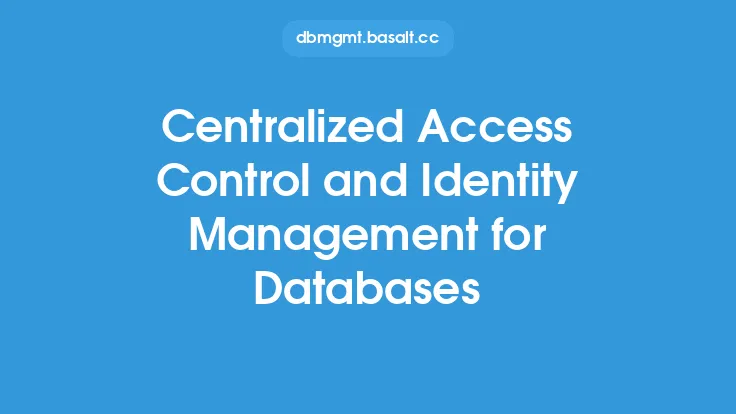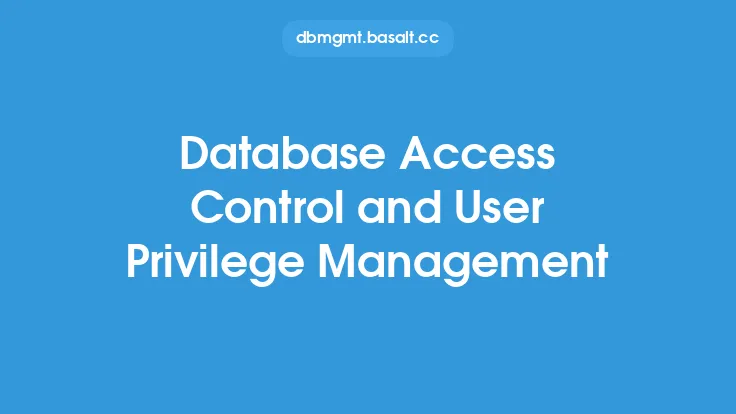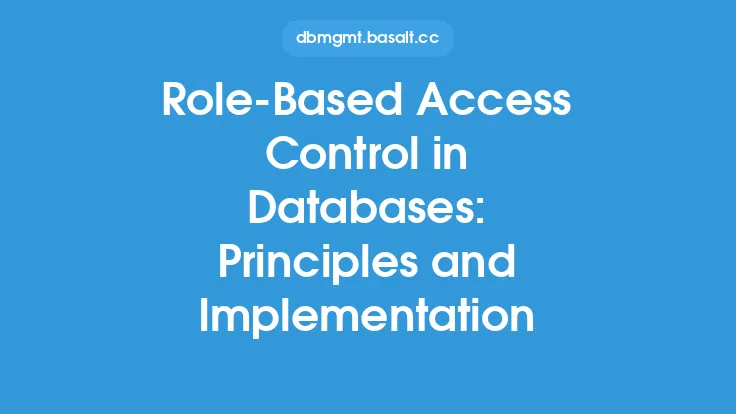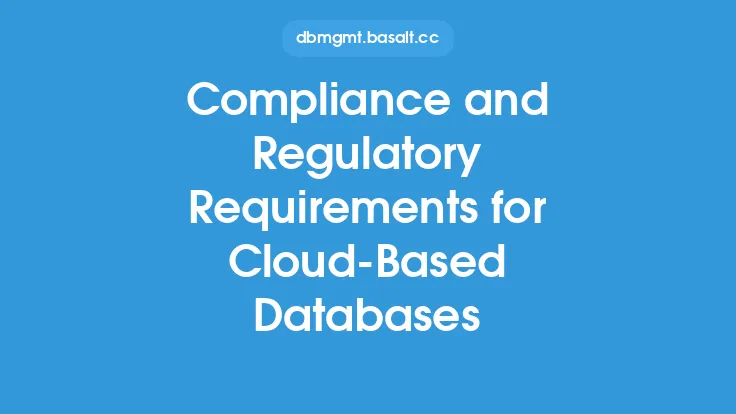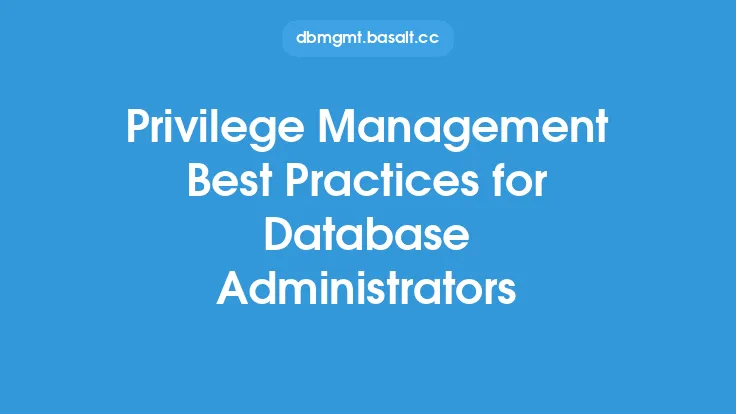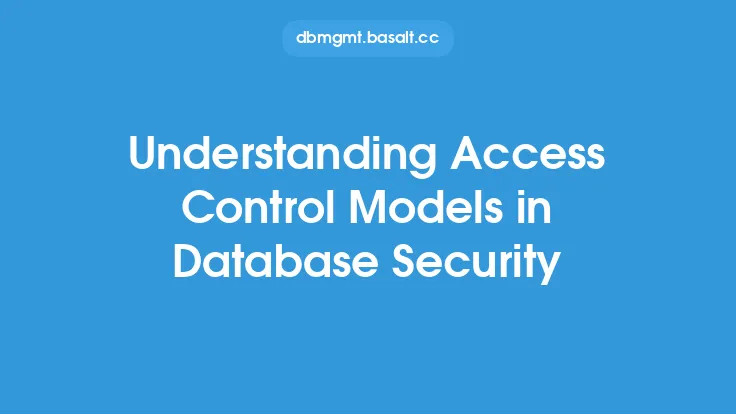As organizations increasingly move their data to cloud databases, ensuring the security and integrity of this data becomes a top priority. One crucial aspect of cloud database security is access control and privilege management, which involves controlling who has access to the database and what actions they can perform. In this article, we will delve into the world of access control and privilege management for cloud databases, exploring the concepts, benefits, and best practices for implementing a robust security framework.
Introduction to Access Control and Privilege Management
Access control and privilege management are two interconnected concepts that work together to ensure that cloud database resources are protected from unauthorized access and malicious activities. Access control refers to the process of granting or denying access to database resources, such as data, schema, or functionality, based on a user's identity, role, or permissions. Privilege management, on the other hand, involves managing the permissions and privileges assigned to users or roles, ensuring that they have the necessary access to perform their tasks without compromising the security of the database.
Benefits of Access Control and Privilege Management
Implementing a robust access control and privilege management system for cloud databases offers numerous benefits, including:
- Improved security: By controlling access to database resources, organizations can reduce the risk of data breaches, unauthorized modifications, and other malicious activities.
- Compliance: Access control and privilege management help organizations comply with regulatory requirements and industry standards, such as GDPR, HIPAA, and PCI-DSS.
- Reduced risk of insider threats: By limiting privileges and access to sensitive data, organizations can minimize the risk of insider threats, such as data theft or unauthorized modifications.
- Increased productivity: With a well-designed access control and privilege management system, users can access the resources they need to perform their tasks efficiently, without requiring excessive permissions or access.
Key Components of Access Control and Privilege Management
A robust access control and privilege management system for cloud databases typically consists of the following key components:
- Authentication: The process of verifying the identity of users, services, or applications attempting to access the database.
- Authorization: The process of determining what actions a user or service can perform on the database, based on their identity, role, or permissions.
- Role-based access control: A mechanism for assigning permissions and privileges to users based on their roles or responsibilities.
- Attribute-based access control: A mechanism for assigning permissions and privileges based on user attributes, such as department, job function, or security clearance.
- Auditing and logging: The process of tracking and recording all access and modifications to the database, to detect and respond to security incidents.
Best Practices for Implementing Access Control and Privilege Management
To implement a robust access control and privilege management system for cloud databases, organizations should follow these best practices:
- Implement a least privilege approach, where users and services are granted only the necessary permissions and access to perform their tasks.
- Use role-based access control to simplify permission management and reduce the risk of privilege creep.
- Regularly review and update access controls and privileges to ensure they remain aligned with changing business needs and user responsibilities.
- Use attribute-based access control to provide fine-grained access control and reduce the risk of over-privileging.
- Implement auditing and logging to detect and respond to security incidents, and to demonstrate compliance with regulatory requirements.
Cloud Database Access Control and Privilege Management Tools
Several tools and technologies are available to help organizations implement access control and privilege management for cloud databases, including:
- Cloud provider-native tools, such as AWS IAM, Azure Active Directory, and Google Cloud IAM.
- Third-party access control and privilege management solutions, such as Okta, Ping Identity, and SailPoint.
- Database-specific tools, such as Oracle Database Vault, Microsoft SQL Server Audit, and PostgreSQL row-level security.
- Open-source tools, such as Apache Ranger, Apache Knox, and OpenLDAP.
Challenges and Limitations of Access Control and Privilege Management
While access control and privilege management are essential for cloud database security, several challenges and limitations can arise, including:
- Complexity: Implementing and managing access control and privilege management systems can be complex, especially in large, distributed environments.
- Scalability: As the number of users, services, and database resources grows, access control and privilege management systems must scale to accommodate the increased demand.
- Integration: Integrating access control and privilege management systems with existing identity and access management infrastructure can be challenging.
- User experience: Overly restrictive access controls can negatively impact user productivity and experience, while overly permissive access controls can compromise security.
Future of Access Control and Privilege Management
As cloud databases continue to evolve, access control and privilege management will play an increasingly important role in ensuring the security and integrity of cloud database resources. Emerging trends and technologies, such as:
- Artificial intelligence and machine learning: Can help improve access control and privilege management by detecting anomalies, predicting user behavior, and automating permission management.
- Cloud-native access control: Can provide more fine-grained access control and privilege management, leveraging cloud provider-native tools and services.
- Zero trust architecture: Can help organizations implement a more robust and adaptive access control and privilege management system, by verifying the identity and permissions of all users and services, regardless of their location or affiliation.
Conclusion
Access control and privilege management are critical components of cloud database security, ensuring that sensitive data and resources are protected from unauthorized access and malicious activities. By understanding the concepts, benefits, and best practices for implementing access control and privilege management, organizations can improve the security and integrity of their cloud databases, reduce the risk of data breaches and insider threats, and demonstrate compliance with regulatory requirements. As cloud databases continue to evolve, it is essential to stay informed about emerging trends and technologies, and to adapt access control and privilege management strategies to meet the changing needs of the organization.
